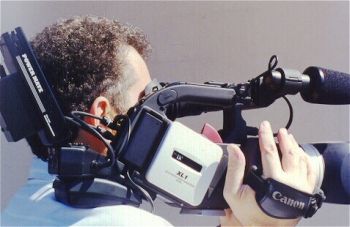The XL1 Watchdog
|
> top of page < |
The Dolgin Engineering Power Mate PM-1000
a review by Don Palomaki
Dolgin Engineering has released several accessories for the Canon XL1 camcorder. This note examines the PM-1000, Power Mate battery voltage adapter.
The unit performs as advertized, is easy to install and use, and offers a useful alternative to powering the XL1, especially for users who already have an investment in Panasonic BP20 batteries.
The PM-1000 adapter is designed to enable powering the XL1 from a 12 volt DC source, with specific support for the Panasonic 12 volt, 2.0 amp-hour gell cell batteries as used with the AG-456 and related camcorders. The Panasonic BP20 batteries fit in a slot on the PM-1000 and a provided clip/cord connects the battery to the PM-1000. You can use other Panasonic (and clone) batteries such as the BP50 and the 2.3 AH models too, just check for a fit. In addition, the PM-1000 includes a 4-pin XLR jack so other 12-14 volt batteries can be used as the primary power source.
The PM-1000 mounts on the Canon MA-100 XLR microphone adapter and can be installed in place of or in addition to the bracket furnished with the MA-100. The DC-900 cable furnished with the XL1 is used to connect the PM-1000 to the XL1. However, Dolgin Engineering offers an optional power connector with shorter cord cut to the correct length (makes for a neater installation).
The PM-1000 has three red LEDs that indicate the current battery voltage, 12, 11.5, and 11 volts. This will give an indication of the remaining available battery runtime. The manual suggests that with the 2.0 amp-hour Panasonic battery you will have about 5-10 minutes left when the 11-volt LED goes out. Note that , the visual battery indicator on the XL1 is disconnected when an external power source (something other than a Lithium ion battery in the battery compartment) such as the DC-900 cord is used, so the LEDs are the most effective and efficient way to display battery status.
With a BP20 battery (not furnished) the PM-1000 adds about 2 pounds to the weight of the X1, and it shifts the balance point (center of gravity) a bit over 2" to the rear putting it behind the tripod socket roughly under the Standby button. Because the PM-1000's weight is fully over the shoulder pad, it does not add to the weight carried by the users arms during typical on-the-shoulder shooting. However, the weight is there if you are doing hands-over-the-head shooting, and subjectively it tends to smooth out camera movement a bit.
It takes but a minute or two to unpack and install the PM-1000 using the screws furnished with the MA-100. Because you can retain the MA-100 bracket, you still have a place to hang your wireless receiver. Tests (using a dummy load) indicate that the adapter provides the specified 7.2 volts to power the camcorder and can do so reliably with input battery voltages down to 9 volts dc (although going this low with a 12 volt battery generally is not good for the battery). The voltage is fairly clean DC, with less than 30 millivolts of ripple voltage (and the ripple at a very high frequency). The adapter uses high frequency (just below AM broadcast frequencies) switching regulation, so it has a high energy efficiency, about 88% or better in my tests, which is substantially better than the 60% you could achieve with a simple series regulator, and this has the effect of extending battery runtime. There was no noticeable heat generated in the PM-1000. The battery voltage LEDs turn on/off at the specified voltages. Note that as batteries age, the amount of runtime, including the runtime remaining after the 11-volt LED goes out will decrease. In my on-camcorder tests with a fairly new battery, the 11.5-volt LED ran out after about 1:20 of runtime, and the 11-volt LED turned off about 10 minutes later. This was using the camcorder in the "green box" mode, at LP speed on a tripod and no zooming. (Your mileage may be different.) Thus it is probably best to change the battery as soon as you can after the 11 volt LED goes out, but you may be changing that battery a bit earlier as you change tape if you adopt the suggested practice of placing the camcorder in standby when not rolling tape. In use, the LEDs are by your right ear so with a simple turn of the head you can check status.

The PM-1000 works, but why would you use it instead of just buying more Lithium ion batteries? Well, it is a business decision and here are some points to consider. The BP20 gel cell batteries are substantially lower cost than Lithium ion. You may already have a substantial inventory of the BP20 (or similar 12- volt batteries, perhaps belt packs) for use with other equipment you already own. This means fewer different items in your field kit and the PM-1000 can extend their usefulness. The lead-acid battery technology is well established and reliable, and it is easier to find replacements and chargers while in the field than for Lithium ion. The PM-1000 carries a one-year limited warranty covering defects in material and manufacturing. Dolgin Engineering is also developing a version mounted on shoulder brace for the XL1, and a version that is not equipped with the BP20 battery slot.
For more information and pricing, contact:
Alex Dolgin
Dolgin Engineering
Lexington, Massachusetts
dolgin@alexvideo.com
Back to the XL1 Articles Menu
Thrown together by Chris Hurd
Please direct questions to the DV Info Net Community Forums.
Where to Buy: These dealers are authorized DV Info Net sponsors... | |||
|
|
|
|
|
|
|
|
Please support this site by making your purchases through them. Thanks! | |||
©1998-2008 DV Info Net
The Digital Video Information Network
San Marcos, Texas
A guilty man runs when no one is chasing him.
